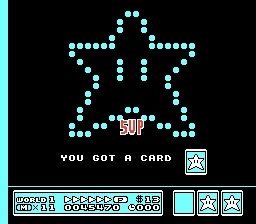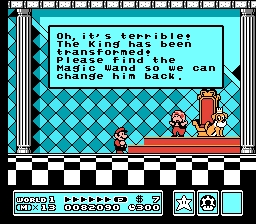 Joking aside, there actually is a lot going on in this game. Instead of kidnapping Princess Toadstool, Bowser has instead sent his army of children to enslave the seven kingdoms of Mushroom World, whi
Joking aside, there actually is a lot going on in this game. Instead of kidnapping Princess Toadstool, Bowser has instead sent his army of children to enslave the seven kingdoms of Mushroom World, whi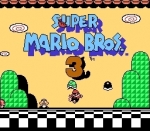
I usually hate blanket terms like "the best" anything, but let's be honest here, on the NES there was one game that was a shining example of what the machine could do. It had the graphics, it had the speed, it had the music, and it had the two player battle mode. That game was Super Mario Brothers 3.
Released in Japan on October 23rd, 1988, which is 25 years ago, Mario 3 made it to the United States in February 1990, presumably due to all the dialog that had to be translated. I mean, let's face it, with over twenty lines of dialog, this game had probably the most immersive story seen in video games at the time.
 Joking aside, there actually is a lot going on in this game. Instead of kidnapping Princess Toadstool, Bowser has instead sent his army of children to enslave the seven kingdoms of Mushroom World, whi
Joking aside, there actually is a lot going on in this game. Instead of kidnapping Princess Toadstool, Bowser has instead sent his army of children to enslave the seven kingdoms of Mushroom World, whi
ch oddly, does not seem to include the Mushroom Kingdom. The plan here was to turn the kings into silly animals, and rule from their floating airships. Okay, so I guess he also kidnaps the princess, but that's not the point. The point is, where did Bowser's children come from? I've never seen a female Koopa, and even if I had, I mean… It would be like putting a sausage into a pinhole. Come on. I guess we can only assume that the events of the original Super Mario Brothers took long enough for some hot Bowser x Toadstool slashfic.
Uhm… Moving right along, the people of the Mushroom World contact Mario and green Mario to help them save their kingdoms and restore the tenets of truth, justice, and the American Mushroom way. So the Princess wishes Mario and Luigi good luck--Wait a minute, how could she be there at the start of their journey? Was she actually kidnapped by Bowser during the game? Perhaps the whole attacking other kingdoms thing was just a ploy to distract Mario while Bowser took his real prize. I guess we'll never know.
This game actually really means a lot to me. It's one of the first games I ever played, and I think is a shining example of the marque. It took everything that was great about the first Super Mario Bros. game, threw out the weird dreamland panic that Nintendo of America called Super Mario Bros. 2, and improved on the formula in every conceivable way. To me, this game defined the Mushroom world in a way that couldn't be rivaled except by Dinosaur Land in Super Mario World, which still fits in to the whole universe created by Super Mario Bros. 3!
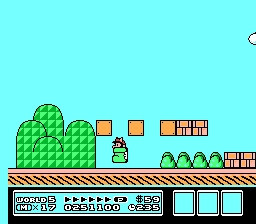 The level design is nothing short of incredible. It might seem trite and easy when you start, but you have to remember, the game was made in an era before saves...Were common. Each stage is small by todays standards, but especially in later worlds, they have a challenge to them that makes seeing the black goals an exciting feat. There need not be a checkpoint, because although difficult, once you've done it a few times, it doesn't take long to get back to where you were. Plus, you get all of the power ups from the beginning of the stage--Something which has stuck with me today, I tend to avoid checkpoints even if they're present.
The level design is nothing short of incredible. It might seem trite and easy when you start, but you have to remember, the game was made in an era before saves...Were common. Each stage is small by todays standards, but especially in later worlds, they have a challenge to them that makes seeing the black goals an exciting feat. There need not be a checkpoint, because although difficult, once you've done it a few times, it doesn't take long to get back to where you were. Plus, you get all of the power ups from the beginning of the stage--Something which has stuck with me today, I tend to avoid checkpoints even if they're present.
In classic Mario style, each world has a theme, and the levels in that stage progress through that theme, each building on elements from the level before it. Starting with the Grass Land's simple levels, mimicking those we've seen in previous Mario games, through to the difficult Sky Land (Or as I call it, the Cloud Imperium) in which the player almost has to use the Tanooki suit or racoon tail. Speaking of which, in what way does that help you fly?
One of the defining characteristics of this game are the multiple paths to the goal. Even in World 1, you can see that some scenes don't have to be cleared in order to make it to the end. But even more than this, in each scene, there are loads of possibilities. Just as in other Mario games, pipes may lead to a secret underground cavern that pops you out right at the goal. Sometimes, flying up above the enemies brings you another whole level to play, complete with its own enemies and obstacles. And it doesn't end there; the multitude of items present in this game means you can run through the exact same path, and have a completely unique experience to the person playing beside you. No matter who you watch playing the game, chances are they'll play it differently than you.
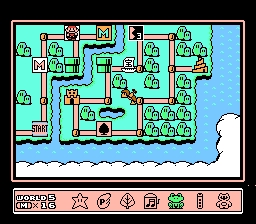 I think that's important in games. Platforming is kind of gone these days, but back when consoles first started exploring 3D gameplay, it was everywhere, and everyone had a different way of doing things, but commonly, to keep the levels small enough that players wouldn't get lost, we're left with very linear, clear-cut objectives that play exactly the same no matter what you try to change.
I think that's important in games. Platforming is kind of gone these days, but back when consoles first started exploring 3D gameplay, it was everywhere, and everyone had a different way of doing things, but commonly, to keep the levels small enough that players wouldn't get lost, we're left with very linear, clear-cut objectives that play exactly the same no matter what you try to change.
This is also perhaps one of the first console games to include a throwback to another classic Nintendo game, and of course, I'm talking about the two player battle mode. For those not in the know, Super Mario Brothers is based on an older Nintendo title, Mario Brothers (Go figure). In this game the object was to kill enemies (and clean the pipes) faster than your brother without dying. In Super Mario Bros. 3, this game makes a comeback as a minigame that can affect the outcome of the larger Mario 3 game. The player that wins the minigame can take your bonus cards, and gains control of the overworld. If you're an evil big brother with a quick thumb, you can essentially play a one player game, while still beating your siblings into submission. Not that I did that… I only used the minigame for fun!
What would a Super Mario Brothers 3 review be without mentioning one of the biggest deceptions in gaming? By now almost everybody has seen the videos alerting us that this was, in fact, a stage show put on by Mario and his friends, but this fact has been obscured by the mists of time, and only in the past handful of years has it resurfaced. One of the things I find funniest about this whole ordeal is, it was never a secret. You have, for instance, the curtain rising and falling at the beginning and end of the game, but also references to stages in the manual, and the obviously cobbled-together backdrops used on most levels. It's actually kind of a fun way to explain how things can mysteriously float in a platformer. Many of the quirks from this game were carried on to other Mario games, such as certain platforms following a path cutout in the background, and objects casting shadows on the sky. Why this idea was put in the game and not expanded upon in the instruction manual or any other media is beyond me. Perhaps this is just a localization error, or the team at Nintendo of America thought western audiences wouldn't get it? Or maybe when creating the game, R&D4 thought it would be obvious enough that it didn't need to be spelled out for us. Whatever the case, this has created quite an interesting array of theories about the game and continues to entertain us to this day.
This year marks the 25th anniversary of Super Mario 3, and while most of the world will go on without notice, we think this occasion should at least be mentioned, because like it or not, the third installment of this iconic franchise cemented the style of Mario for years to come, and with games like New Super Mario Bros and Super Mario 3D Land closely mimicking it's style, it's safe to say that even Nintendo knows how great this game was. Having been re-released in every gaming generation, often with graphical updates, Super Mario Brothers 3 is definitely a quality game worthy of the Nintendo Seal of Approval it earned all those years ago.
